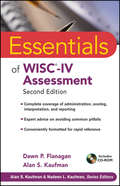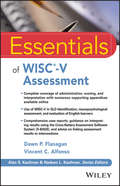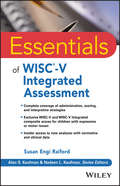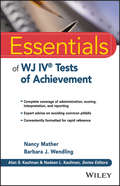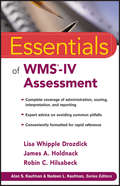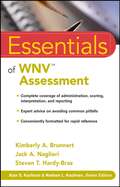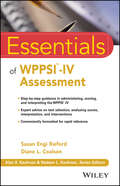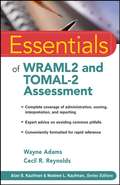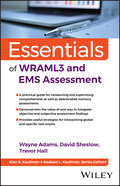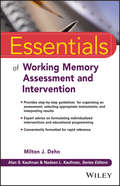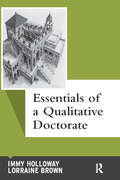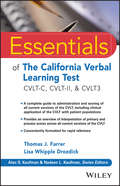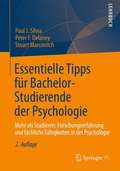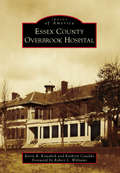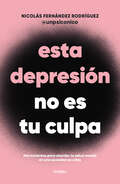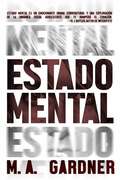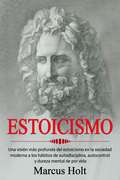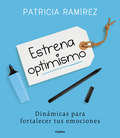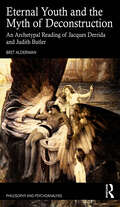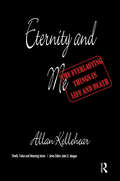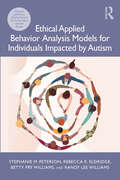- Table View
- List View
Essentials of WISC-IV Assessment
by Alan S. Kaufman Dawn P. FlanaganThe WISC-IV is the top intelligence assessment instrument for children in the US, providing essential information into a child s cognitive functioning. Essentials of WISC-IV Assessment with CD-ROM, Second Edition presents professionals with step-by-step instruction on scoring and interpreting this test. Thoroughly updated, the new edition is now packaged with a CD-ROM for interpreting and scoring the WISC-IV. In addition, each chapter has been fully revised. Anyone involved in the psychological testing of children, specifically school psychologists and clinical psychologists, will benefit from this popular measure of intelligence.Note: CD-ROM/DVD and other supplementary materials are not included as part of eBook file.
Essentials of WISC-V Assessment (Essentials of Psychological Assessment)
by Dawn P. Flanagan Vincent C. AlfonsoThe comprehensive reference for informative WISC-V assessment Essentials of WISC-V Assessmentprovides step-by-step guidance for administering, scoring, and interpreting the Wechsler Intelligence Scale for Children (WISC-V). Packed with practical tips for more accurate assessment, this informative guide includes numerous case studies that illustrate a range of real-world issues. Special attention is devoted to the assessment of individuals who have significant learning difficulties, such as learning disabilities, and who speak English as a second language. The WISC-V is a valuable assessment tool, but it must be administered and scored appropriately to gain meaning from score interpretation. This book gives you an in-depth understanding of the WISC-V assessment and interpretive process to assist practitioners in: Conducting efficient and informative WISC-V assessments Utilizing WISC-V in cross-battery and neuropsychological assessment Applying WISC-V in the identification of specific learning disabilities Utilizing WISC-V in nondiscriminatory assessment of English language learners Writing theory-based WISC-V reports Linking WISC-V findings to interventions based on individual performance As the world's most widely-used intelligence test for children, the WISC-V is useful in diagnosing intellectual disabilities and specific learning disabilities, as well as in identifying giftedness. In this volume, sample reports demonstrate how WISC-V assessment results may be linked to interventions, accommodations, modifications, and compensatory strategies that facilitate positive outcomes for children. Essentials of WISC-V Assessment is the all-in-one practical resource for both students and practitioners. The book can be used on its own or with companion software (purchased separately) that provides a user-friendly tool for producing psychometrically and theoretically defensible interpretations of WISC-V performance, and may be used to develop interventions based on each child's strengths and weaknesses.
Essentials of WISC-V Integrated Assessment (Essentials of Psychological Assessment)
by Susan Engi RaifordPractical, in-depth guidance for WISC-V and WISC-V Integrated assessment Essentials of WISC-V Integrated Assessment is the ideal companion for psychologists and other assessment professionals seeking helpful interpretive and practical information beyond the WISC-V and WISC-V Integrated published manuals. Beginning with an overview of the test and its application to educational intervention, this book provides in-depth information on new administrative, scoring, and interpretation procedures specific to the WISC-V and the WISC-V Integrated. Insider access to the WISC-V and WISC-V Integrated standardization data allows the reader to derive new WISC-V composite scores unavailable from other resources. Readers of this book are the first to receive access to these new composite scores, which are designed to be more appropriate for children with expressive language difficulties and motor impairments. The reader also receives exclusive access to four new WISC-V expanded index scores that provide broader measures of visual spatial ability, working memory, auditory working memory, and processing speed. Significant advances in working memory research demand more comprehensive assessment of children with a broader range of abilities and limitations. The reader will learn how to perform a highly comprehensive assessment of working memory with the WISC-V and the WISC-V Integrated. A digital interpretive tool automatically calculates the new composite scores, completes the relevant comparisons, and generates interpretive information for new comparisons to streamline the reporting process. The WISC-V Integrated serves to expand and clarify WISC-V results by helping practitioners better understand a child's cognitive processes and the reasons for low or discrepant performance. This book helps practitioners get more out of the WISC-V and the WISC-V Integrated, with indispensable guidance and practical tools. Understand the WISC-V Integrated and its proper application to the development of educational interventions Learn how administration, scoring, and interpretation has changed for retained subtests, how to administer and score new subtests, and how to obtain the first-ever composite scores Discover how to use the WISC-V and WISC-V Integrated to assess both auditory and visual working memory, and how to obtain an unparalleled and in-depth picture of working memory along a continuum of cognitive complexity Learn how to adjust WISC-V use for children with expressive or motor difficulties Explore alternative composite scoring based on the WISC-V and WISC-V Integrated standardization data to increase utility for specific populations The WISC-V Integrated is an essential component of the WISC-V assessment process, and Essentials of WISC-V Integrated Assessment is the ideal guide for practitioners.
Essentials of WJ IV Tests of Achievement (Essentials of Psychological Assessment)
by Nancy Mather Barbara J. WendlingComplete coverage of administration, scoring, interpretation, and reporting Expert advice on avoiding common pitfalls Conveniently formatted for rapid reference The hands-on guide for confidently administering, scoring, and interpreting the WJ IV® Tests of Achievement Written by Nancy Mather and Barbara J. Wendling—two experts on the topic—Essentials of WJ IV® Tests of Achievement provides step-by-step guidance for administering, scoring, and interpreting the achievement portion of the WJ IV®.Designed to be an easy-to-use reference, the text goes beyond the information found in the WJ IV® test manual to offer full explanations of the tests and clusters on the WJ IV® ACH. This essential guide also explains the meaning of all scores and interpretive features and includes valuable advice on clinical applications and illuminating case studies. Essentials of WJ IV® Tests of Achievement contains: Concise chapters that feature numerous callout boxes highlighting key concepts, bulleted points, and 'Test Yourself' questions Separate chapter on the use and interpretation of the WJ IV® Tests of Oral Language and how the WJ IV® ACH and WJ IV® OL can be used together to increase diagnostic utility Expert assessment of the test's relative strengths and weaknesses This accessible resource highlights the most informative aspects of WJ IV® ACH, points out common errors, and reviews the complexities of administration and scoring the Woodcock-Johnson Tests of Achievement.
Essentials of WMS-IV Assessment
by James A. Holdnack Robin C. Hilsabeck Lisa W. DrozdickQuickly acquire the knowledge and skills you need toconfidently administer, score, and interpret the WMS®-IVComplete coverage of administration, scoring,interpretation, and reportingExpert advice on avoiding common pitfallsConveniently formatted for rapid referenceThe most recent revision of one of the most popular memory assessment instruments, the Wechsler Memory Scale-Fourth Edition (WMS®-IV) is a widely used measure of memory functioning, which is particularly useful in the assessment of individuals with dementia, traumatic brain injury, and substance abuse problems, among others. Professionals need an authoritative source on administration, scoring, and interpretation in order to use this test properly. Written by the test developers for the WMS®-IV, Essentials of WMS®-IV Assessment is that source.Like all the volumes in the Essentials of Psychological Assessment series, this book is designed to help busy mental health professionals, and those in training, quickly acquire the knowledge and skills they need to make optimal use of major psychological assessment instruments. Each concise chapter features numerous callout boxes highlighting key concepts, bulleted points, and extensive illustrative material, as well as test questions that help you gauge and reinforce your grasp of the information covered.Integrating WMS®-IV data with the WAIS®-IV and other measures of cognitive ability and memory for adults, Essentials of WMS®-IV Assessment now includes four new subtests and a revised index structure. The authors also offer expert assessment of the test's relative strengths and weaknesses, valuable advice on its clinical applications, and several illuminating case studies.
Essentials of WNV Assessment
by Jack A. Naglieri Steven T. Hardy-Braz Kimberly A. BrunnertEssentials of WNV Assessment provides practitioners with practical, step-by-step advice for administering, scoring, and interpreting the Wechsler Nonverbal Scale of Ability (WNV), a nonverbal assessment used to assess a wide variety of individuals. Written by Kimberly Brunnert, Jack Naglieri, and Steven Hardy-Braz, the test is especially well suited for those who are not proficient in English, such as young children, recent immigrants, ESL students, and the deaf and hard of hearing. This essential guide provides you with illuminating case reports and valuable advice on its clinical applications.
Essentials of WPPSI-IV Assessment (Essentials of Psychological Assessment)
by Diane L. Coalson Susan Engi RaifordExploit the full potential of the WPPSI-IV with analysis from multiple perspectives Essentials of WPPSI-IV Assessment is a comprehensive guide to administering, scoring, and interpreting the latest edition of the Wechsler Preschool and Primary Scale of Intelligence, which represents a major revision of the prior edition. Step-by-step guidelines walk readers through the process, and new Behind the Scenes boxes provide unprecedented insight into the new subtests and the test development process. The book highlights common errors and complex aspects so readers can avoid them, and includes illustrative case studies based on data collected during the scale's standardization to assist in proper administration and interpretation. The companion CD provides software that automates score interpretation, and supplies users with tools to enhance WPPSI-IV administration and report writing. Used to evaluate for learning or intellectual disabilities, developmental or language delays, or gifted and talented classification, the Wechsler Preschool and Primary Scale of Intelligence is the most widely used assessment of intelligence for young children. Essentials of WPPSI-IV Assessment applies an interpretive approach that allows flexibility in response to the real constraints and challenges inherent in working with children, describing performance in both normative and interpersonal contexts to facilitate interpretive case formulations from multiple theoretical and clinical perspectives. Topics include: WPPSI-IV administration and clinical applications Scoring, score analysis, and interpretation Strengths and weaknesses of the WPPSI-IV Differences across demographic groups The book and accompanying CD also provide alternatives for situations in which published comparison scores may not be available or applicable to a particular child, and supplies composite scores aimed at facilitating WPPSI-IV interpretation from a variety of theoretical approaches. Those who employ the WPPSI-IV must have a thorough grasp of the full potential of the tool, and Essentials of WPPSI-IV Assessment contains the insight and information that allow for deeper understanding.
Essentials of WRAML2 and TOMAL-2 Assessment
by Cecil R. Reynolds Wayne AdamsEssentials of WRAML2 and TOMAL-2 Assessment introduces professionals to these two widely used memory measurement batteries, both of which measure memory and are used to supplement evaluations of ADHD and reading problems in youngsters, as well as a number of other disorders across the age span. Written by Wayne Adams and Cecil Reynolds, this essential reference provides administration guidelines, including procedural suggestions and solutions for common problems examiners may encounter; expert assessment of each test?s relative strengths and weaknesses; valuable advice on clinical applications; and illuminating case reports.
Essentials of WRAML3 and EMS Assessment (Essentials of Psychological Assessment)
by Wayne Adams David Sheslow Trevor A. HallDevelop your memory assessment expertise with WRAML3 and EMS mastery Essentials of WRAML3 and EMS Assessment allows you to dive deep into the intricacies of memory assessment and gain proficiency in making holistic, meaningful recommendations on the basis of test scores and subjective assessments. Explore the latest enhancements in the second version of WRAML, featuring a Performance Validity measure, heightened emphasis on delayed recall and working memory, more nuanced scoring, and an additional abbreviated format. This book will also help you develop expertise in administering the subjective EMS assessment tool, capturing everyday memory in addition to the more clinical information offered by the WRAML. Understand the nuances of memory assessment with visual cues highlighting crucial points Develop practical expertise with step-by-step guidelines that go beyond the official testing manuals. Gain a deeper knowledge of memory assessment with integrated theoretical and research content Enhance your own professional development or train students and colleagues in a multifaceted memory assessment approach This comprehensive guide will elevate your memory assessment skills for children and adults, ensuring your recommendations are both informed and impactful.
Essentials of Working Memory Assessment and Intervention (Essentials of Psychological Assessment)
by Alan S. Kaufman Nadeen L. KaufmanImprove academic learning outcomes with accurate working memory assessment and evidence-based interventions Essentials of Working Memory Assessment and Intervention is an accessible, practical guide to accurately and efficiently assessing working memory. This comprehensive resource explains the theories of working memory, with an emphasis on cognitive load theory, and provides step-by-step guidelines for organizing a cross-battery assessment, selecting appropriate instruments, interpreting results, and formulating individualized interventions and educational programming. In-depth case studies illustrate typical profiles found in children and adolescents with working memory deficits, and the companion CD features worksheets, testing charts, and other useful resources. Reader-friendly design elements including Rapid Reference, Caution, and Don't Forget boxes, and practice questions, bullet points, and icons make this guide useful for both study and desk reference. Working memory deficits are the main reason why students with disabilities are unable to successfully respond to regular education interventions. Given the strong relationship between working memory and all areas of academic learning, a deeper understanding of working memory and the related assessments and interventions can facilitate greater achievement. This book helps readers: Understand the development and neuroanatomy of working memory Learn techniques for improving working memory in the classroom Examine strategies for brain-based working memory training Effectively utilize working memory assessment measures By examining the critical functions of working memory and its relationship with specific learning disabilities, then providing strategies for assessment and detailed intervention guidance, this book helps educatorsand professionals guide their students and clients toward improved cognitive functioning, , reduced frustration, and improved academic performance . For those seeking a practical approach to working memory, Essentials of Working Memory Assessment and Intervention provides the tools and information they need.
Essentials of a Qualitative Doctorate (Qualitative Essentials #8)
by Immy Holloway Lorraine BrownHave you been working toward a qualitative doctorate without a guide? Immy Holloway and Lorraine Brown are here to help. Breaking down the process step by step, this book gives essential advice on navigating the whole program. You’ll first get some tips on selecting a research topic and writing a proposal. From there, you’ll receive guidance on your research journey, all the way through the completion (and publication!) of your dissertation. Also included is a helpful recommended reading list broken down by research area. This book is an excellent resource for doctoral students of qualitative research and for those who are still considering whether to make the leap.
Essentials of the California Verbal Learning Test: CVLT-C, CVLT-2, & CVLT3 (Essentials of Psychological Assessment)
by Lisa W. Drozdick Thomas J. FarrerPart of Wiley's Essentials of Psychological Assessment series, this book covers the administration, scoring, and interpretation of the CVLT-C, CVLT-II, and CVLT-3. Additionally, readers will find a discussion of the strengths and weaknesses of the assessment, a review of the CVLT's performance in clinical populations, and illustrative case reports. Each chapter ends with a Test Yourself section for enhanced learning. Essentials of the California Verbal Learning Test: CVLT-C, CVLT-2, & CVLT3 is a perfect resource for anyone who needs to understand and use the CVLT assessments.
Essentielle Tipps für Bachelor-Studierende der Psychologie
by Stuart Marcovitch Peter F. Delaney Anna Seemüller Paul J. SilviaVielleicht haben Sie erst nach Studienbeginn ernüchtert festgestellt, dass das Psychologie-Studium anders ist, als Sie es sich vorgestellt hatten. Akademische Psychologie ist weitreichend und tiefgründig, wissenschaftlich und statistisch. Eine entscheidender Schwerpunkt im Studium der Psychologie ist die Forschung, die im Master- oder Promotionsstudium vertieft wird. Dieser humorvoll geschriebene und einfach zu lesende Wegweiser dient Ihnen zur Vorbereitung und zur praktischen Weichenstellung für die Zeit im und nach dem Bachelor-Studium. Das Werk macht Lust darauf, Forschungserfahrung als eine großartige Gelegenheit zu sehen, um fachliche Fähigkeiten auf- und auszubauen. Diese Forschungserfahrungen werden nicht nur als wichtige Kompetenz für eine wissenschaftliche, sondern auch für eine berufliche Karriere angesehen. Die zahlreichen Hinweise und Tipps können während dem Bachelorstudium angewendet werden, um später den gewünschten Nutzen zu bringen. So können Sie gezielt und effektiv die Vorbereitungen für eine erfolgreiche Karriere treffen.
Essenz der Führung
by Martina Aron-WeidlichWas genau sollte eine Führungskraft wissen, um professionell und zielorientiert führen zu können? Aus einer Vielzahl von Methoden, Werkzeugen und Handlungsanweisungen bietet dieses Buch eine Auswahl an kompakt aufbereitetem Führungswissen - stets mit Fokus auf Praxisnähe und Umsetzbarkeit. Beispiele aus der Führungspraxis zeigen verschiedene Führungskulturen in unterschiedlichen Branchen. Checklisten und Handlungsleitfäden helfen bei der effektiven Umsetzung komplexer Führungsaufgaben.
Essex County Overbrook Hospital (Images of America)
by Robert L. Williams Kevin R. Kowalick Kathryn CataldoWhat was founded as the Essex County Lunacy Asylum evolved from a single building on South Orange Avenue to a city within itself in Cedar Grove. It was named the Essex County Overbrook Hospital. Construction began on the hospital's iconic brick buildings in 1896, and they were prominent features on Fairview Avenue for the next 100 years. The facility produced its own food, housed its own police and fire departments, and sustained its own power sources. The Essex County Overbrook Hospital was recognized throughout the world as a leader in psychiatric care. In later years, overcrowding began to plague the institution. However, after the advent of modern psychiatric drugs, many patients were able to be discharged back into the community. In 2007, the buildings were closed, and the hospital was relocated to a newer establishment nearby. The grounds have since been plagued with vandalism and neglect, with a final deal for demolition having been solidified in 2015.
Esta depresión no es tu culpa
by Nicolás FernándezEn una sociedad que ha descuidado la salud mental para privilegiar la productividad, el psicólogo y creador de contenidos en Instagram @unpsiconico propone una mirada comunitaria para sanar y alejarse del positivismo tóxico. El psicólogo Nicolás Fernández echa por tierra afirmaciones como "primero debes quererte a ti mismo para que te quieran", "vamos que se puede", "es cuestión de ánimo" y otras frases hechas patentadas por el positivismo tóxico y, en cambio, promueve las buenas prácticas colectivas y políticas para combatir la pandemia de salud mental que es la depresión. Con guiños a su propia experiencia como paciente y terapeuta, Esta depresión no es tu culpa entrega herramientas y una mirada contenedora y colaborativa frente a un tema de preocupación global.
Estado mental
by M. A. GardnerEstado Mental es un emocionante drama sobrenatural y una exploración de la dinámica social adolescente que te romperá el corazón. -D. J. Butler, autor de Witchy Eye Steven y Lindsay peleaban constantemente. Pero no siempre fue así. En un giro trágico de su historia de amor, Lindsay dice que las voces la obligan. Cuando ella es incapaz de resistir el canto de sirena del olvido, Steven se queda con los jirones que era su vida juntos. Todos creen que él tuvo algo que ver con su suicidio. En secreto, incluso cuestiona si hubo una voz. Eso es hasta que el mismo escucha la voz...
Estoicismo: moderna a los hábitos de autodisciplina, autocontrol y dureza mental de por vida
by Marcus HoltHay muchas joyas escondidas en la historia que, si se llegaran a descubrir, podrían desatar muchísima riqueza física e intelectual, algo necesario para que nuestra sociedad vuelva a la gloria, en medio de los cambios transformativos que trajo el modernismo. La filosofía estoica es una de esas gemas. Es una filosofía antigua que se desarrolló para hacer felices a las personas. Muchas veces la gente busca la felicidad en actividades incorrectas, personas incorrectas y cosas incorrectas. La mayoría se enfoca en sobresalir en tantas cosas que olvidan la alegría del momento. Otros son seres que esperan pasivamente y derivan un sentido de satisfacción de criticar y hablar acerca de otra gente. Este libro habla sobre ambos grupos. A los seres pasivos se les recomienda enfocarse en sus asuntos, con la promesa de que el mirar en su interior y el desarrollo de la virtud los llevará al mayor éxito. A los sobresalientes se les recomienda tomarse un momento para relajarse, enfocarse un poco menos en sus logros y tomarse el tiempo de apreciar sus alrededores. Este libro provee una discusión comprensiva de todo lo relacionado al estoicismo. Establece la fundación de que el estoicismo fue desarrollado en base a la ética, la física y la lógica. El libro también enumera a varios filósofos que han sido instrumentos de la formación y creación de esta filosofía, incluyendo a Séneca el Joven, Catón el Joven, Marco Aurelio y Epicteto. Estas mentes sabias ayudaros a desafiar, cuestionar, aprobar e incluso a desarrollar la filosofía estoica. Además encontrará en este libro una descripción comprensiva de las disciplinas estoicas, incluyendo el deseo, la acción y el consentimiento. La disciplina del deseo está basada en el entendimiento de la física, la cual explica como funciona el mundo. La disciplina del consentimiento aboga por la aplicación de la lógica en la vida cotidiana, mientras que la disciplina de la acción aboga por l
Estoy lejos con Jetro
by Carlo Felice TassiniNovela de ficción que desnuda la dura historia de un hombre que transcurre su vida desde la infancia, sin la presencia de su madre y con un padre ausente y poco afectivo. LLegada su juventud decide alejarse de su padre e intentar hacer su propio proyecto de vida. Durante ese tiempo aprende a sobrellevar su soledad y la intensa necesidad de saber de su madre. Es así que pasado el tiempo y descubriendo huellas ocultas , hará un descubrimiento inesperado, que marcará su vida y la de su futura familia. Una trama digna de ser disfrutada y que les llenará el corazó, de alegría y tristeza a la ves. Punto adicional para el breve cuento final "El pez luna" Una hermosa anécdota de desencuentro que pudo ser algo bello. Hay que leerlo, no vale que lo cuente.
Estrena optimismo
by Patricia RamírezLa vida no es perfecta, pero tu actitud sí puede serlo. El nuevo libro de Patricia Ramírez incluye dinámicas y muchos ejercicios prácticos. Si hasta ahora no has estrenado optimismo, estás de suerte... ¡Hay un montón de optimismo para ti! Ser optimista no te asegura el éxito, pero te ayuda a alcanzarlo. La persona optimista invierte esfuerzo y trabajo en lo que cree que puede tener salida y posee algo muy importante: esperanza. Eso le da ánimo y motivación para seguir intentándolo. El optimismo no se compra, pero sí se puede entrenar, como se entrena la fuerza, la estrategia o la flexibilidad. Y ahora tienes en las manos un libro divertido y práctico que te permitirá cambiar tu estado de ánimo a través de 40 dinámicas. ¡Manos a la obra! Todos tenemos problemas y a veces nos parecen incluso insalvables. Pero la manera en que nos enfrentamos a ellos diferencia al ganador del perdedor, al «disfrutón» del que vive en la apatía y la tristeza constante. Pensar de forma optimista requiere un esfuerzo mayor que hacerlo de forma catastrófica, porque nuestro cerebro tiene una tendencia natural a hacerlo así. Pero recuerda que también posee una cualidad muy importante, la plasticidad. Aprende constantemente y no solo a realizar una nueva receta o a mejorar una habilidad deportiva sino también aprende nuevas formas de pensar y de sentir. Y esa es la base del optimismo. Las 40 dinámicas y ejercicios prácticos que encontrarás en este libro te permitirán entrenar tu optimismo desde el primer día.
Estrena optimismo
by Patricia RamírezLa vida no es perfecta, pero tu actitud sí puede serlo. El nuevo libro de Patricia Ramírez incluye dinámicas y muchos ejercicios prácticos. Si hasta ahora no has estrenado optimismo, estás de suerte... ¡Hay un montón de optimismo para ti! Ser optimista no te asegura el éxito, pero te ayuda a alcanzarlo. La persona optimista invierte esfuerzo y trabajo en lo que cree que puede tener salida y posee algo muy importante: esperanza. Eso le da ánimo y motivación para seguir intentándolo. El optimismo no se compra, pero sí se puede entrenar, como se entrena la fuerza, la estrategia o la flexibilidad. Y ahora tienes en las manos un libro divertido y práctico que te permitirá cambiar tu estado de ánimo a través de 40 dinámicas. ¡Manos a la obra! Todos tenemos problemas y a veces nos parecen incluso insalvables. Pero la manera en que nos enfrentamos a ellos diferencia al ganador del perdedor, al «disfrutón» del que vive en la apatía y la tristeza constante. Pensar de forma optimista requiere un esfuerzo mayor que hacerlo de forma catastrófica, porque nuestro cerebro tiene una tendencia natural a hacerlo así. Pero recuerda que también posee una cualidad muy importante, la plasticidad. Aprende constantemente y no solo a realizar una nueva receta o a mejorar una habilidad deportiva sino también aprende nuevas formas de pensar y de sentir. Y esa es la base del optimismo. Las 40 dinámicas y ejercicios prácticos que encontrarás en este libro te permitirán entrenar tu optimismo desde el primer día.
Eternal Youth and the Myth of Deconstruction: An Archetypal Reading of Jacques Derrida and Judith Butler (Philosophy and Psychoanalysis)
by Bret AldermanIn Eternal Youth and the Myth of Deconstruction, Bret Alderman puts forth a compelling thesis: Deconstruction tells a mythic story. Through an attentive examination of multiple texts and literary works, he elucidates this story in psychological and philosophical terms. Deconstruction, the method of philosophical and literary analysis originated by Jacques Derrida, arises from what Carl Jung called “a kind of readiness to produce over and over again the same or similar mythical ideas.” In the case of deconstruction, such ideas bear a striking resemblance to a figure that Jungian and Post-Jungian writers refer to as the puer aeternus or eternal youth. To make his case, in addition to a careful analysis of numerous Derridean texts, he offers readings of literary works by Milan Kundera, J.M. Barrie, Dante, Apuleius, and others. These texts help illustrate that deconstruction’s preoccupations over questions of presence, deferral, authority, limits, time, and representation are also recurrent issues for the eternal youth as described by Marie-Louise Von Franz and James Hillman. Judith Butler’s deconstruction of sex and gender reflects similar patterns, and she features in this work as a contemporary exemplar of the deconstructive approach. Eternal Youth and the Myth of Deconstruction will be a compelling read for both students and teachers of depth psychology and continental philosophy. The clarity of its style will be appealing to advanced scholars and educated laypersons alike.
Eternity and Me: The Everlasting Things in Life and Death (Death, Value and Meaning Series)
by Allan KellehearThe 40 short reflections in this book address the ways in which we face the prospect of death and loss. The first 20 reflections are designed to be read by (or to) anyone living with a life-threatening illness; the other 20 are reflections on living with grief, especially bereavement. Each reflection is based on a single story drawn from one of three sources: Dr. Kellehear's professional experience with individuals living with dying or loss; his own experiences and stories from childhood; and the retelling of some of the great myths and legends about life, love, and death, selected from around the world-from Ireland to Japan, from Melanesia to China. The book is written to be accessible to a wide general audience.It can be read from beginning to end like a conventional book; each self-contained piece is also suitable for reading on a bus, train, or plane journey, or before bed at night. Each piece can be selected as a stand-alone meditation for use as a discussion topic in pastoral care, counseling, or sermons. These reflections are stories about how we can make the most of life in the shadow of death and loss. They are designed to instill hope and meaning in the difficult times that can accompany human mortality.
Eternity's Sunrise: A Way of Keeping a Diary
by Marion MilnerFollowing on from A Life of One’s Own and An Experiment in Leisure, Eternity’s Sunrise explores Marion Milner’s way of keeping a diary. Recording small private moments, she builds up a store of ‘bead memories.’ A carved duck, a sprig of asphodel, moments captured in her travels in Greece, Kashmir and Israel, circus clowns, a painting - each makes up a 'bead' that has a warmth or glow which comes in response to asking the simple question: What is the most important thing that happened yesterday? From these beads – sacred, horrific, profane, funny – grows a sense of an ‘answering activity’, the result of turning one’s attention inwards to experience real joy. What Marion Milner conveys so vividly and inspirationally is her lifelong intention to live as completely as possible in the moment. With a new introduction by Hugh Haughton, Eternity’s Sunrise will be essential reading for all those interested in reflecting on the nature of their own happiness – whether readers from a literary, an artistic, a historical, an educational or a psychoanalytic/psychotherapeutic background.
Ethical Applied Behavior Analysis Models for Individuals Impacted by Autism
by Betty Fry Williams Randy Lee Williams Stephanie Peterson Rebecca EldridgeEthical Applied Behavior Analysis Models for Individuals Impacted by Autism provides teachers, parents, and behavior analysts with a comprehensive analysis of evidence-based, behavior analytic programs for the therapeutic treatment of persons with autism, from infancy through adulthood. Chapters review the characteristics of autism spectrum disorder (ASD), behavior analytic concepts and interventions, and discuss the eight different effective treatment programs, examining each approach's scientific base and value. Fully updated to reflect current research and understanding of autism, this second edition includes new chapters on evaluating high-quality behavior analytic programs, as well as explorations of programs covering the verbal behavior approach and those specially designed for adults.
